How to Keep Your Dog’s Fur Clean and Tangle-Free: Daily Grooming Guide
Keeping your dog’s fur clean and tangle-free is an essential part of pet care that enhances not only your dog’s appearance but also their comfort and health. Daily grooming prevents matting, reduces shedding, and helps you catch any skin issues early. In this guide, we’ll walk through practical steps and techniques to keep your dog’s coat looking its best. With the right tools and a consistent routine, grooming becomes a manageable, even enjoyable, part of your day.
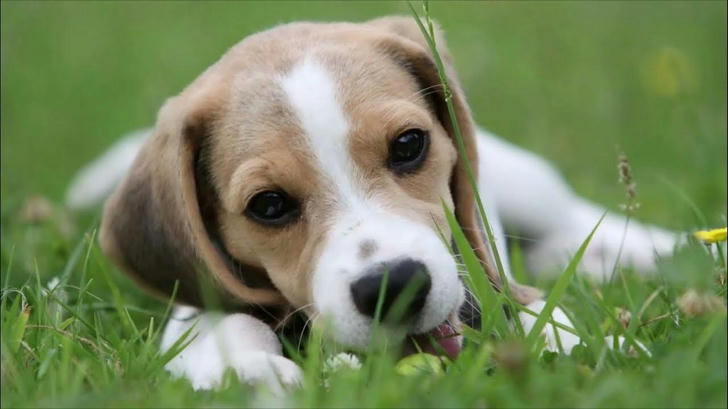
1. Why Daily Grooming is Essential for Your Dog
Daily grooming helps prevent fur tangles, dirt buildup, and skin irritations. Untangled fur ensures air circulates through your dog’s coat, regulating body temperature and preventing hot spots or infections. Grooming also strengthens your bond with your pet, as it creates a positive, calming experience. Furthermore, a regular grooming schedule makes it easier to spot any fleas, ticks, or abnormal skin conditions early.
2. Gather the Right Tools
Before beginning, ensure you have the proper grooming tools. Each tool serves a specific purpose, making the grooming process effective and gentle for your dog. Here are the essentials:
Bristle Brush: For dogs with shorter coats, a bristle brush removes dirt and loose fur.
Slicker Brush: Ideal for long-haired dogs, this helps untangle knots and remove mats.
Comb: A metal comb with both wide and narrow teeth is great for finding and addressing smaller tangles.
Detangler Spray: Especially for long or curly-haired dogs, this spray makes brushing smoother and reduces the risk of hair breakage.
Dog Shampoo & Conditioner: Use only pet-safe products, as human shampoos can irritate a dog’s skin.
Example: For a Labrador Retriever, a bristle brush should suffice, while a Poodle may require a slicker brush and detangler spray.
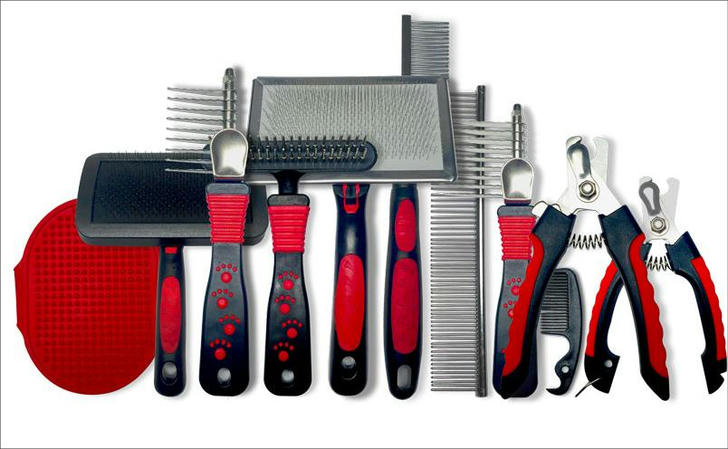
3. Step-by-Step Daily Grooming Routine
A daily grooming routine doesn’t need to be time-consuming. Following a simple 10-15 minute routine ensures your dog’s coat stays clean, manageable, and mat-free.
Step 1: Brush to Remove Dirt and Loose Fur
Start by brushing your dog’s coat with a suitable brush, using long strokes that go in the direction of hair growth. Focus on areas prone to matting, like behind the ears, under the legs, and the belly. If you encounter tangles, gently work through them with a comb or slicker brush, taking care not to pull the skin.
Step 2: Apply Detangler Spray (If Needed)
If your dog has a thick or curly coat, use a detangler spray to soften the fur and make it easier to work through knots. Spray lightly and allow it to sit for a minute before you continue brushing. This reduces pulling, making the experience more comfortable for your dog.
Step 3: Check for Fleas, Ticks, and Skin Issues
Run your hands along your dog’s body to check for any bumps, skin irritations, or parasites like fleas and ticks. Part the fur to see down to the skin, especially around the neck, under the arms, and around the tail. Early detection of skin problems helps you address them before they worsen.
Step 4: Clean the Face and Ears
Gently wipe around your dog’s eyes with a damp cloth to remove any tear stains. Use a dog-safe ear cleaner and a cotton ball to clean your dog’s ears, avoiding inserting anything deep into the ear canal. Regular ear cleaning prevents infections, especially for breeds prone to ear issues, such as Cocker Spaniels.
Step 5: Brush the Tail and Paws
Dogs often develop mats in their tails and around their paws. Use a brush or comb to gently untangle these areas. If your dog has fur between their paw pads, trim it slightly to prevent dirt and debris from getting caught. This also helps them maintain better traction on floors.
Example: For a long-haired dog like a Golden Retriever, paying attention to the tail and paw areas is essential, as these are high-risk areas for tangling and matting.
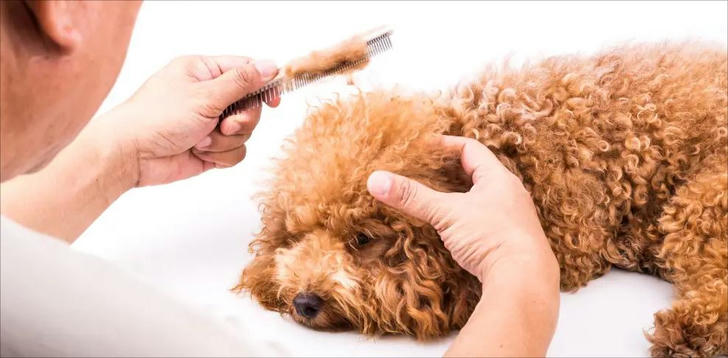
4. Bathing Tips for a Fresh, Clean Coat
While daily bathing is not recommended (as it can dry out your dog’s skin), bathing your dog every 4–6 weeks can help keep their fur clean and shiny. How to Bathe Your Dog Effectively:
**Use Lukewarm Water: Too hot or too cold water can make your dog uncomfortable. Lukewarm water helps keep them calm.
Apply Dog-Safe Shampoo: Work the shampoo into a lather, starting at the neck and working down the body. Avoid the eyes and ears.
Rinse Thoroughly: Leftover shampoo can irritate the skin, so rinse well, ensuring all shampoo is removed.
Condition the Coat (If Necessary): For long or coarse-haired dogs, use a conditioner to make the fur easier to brush post-bath.
Dry Gently: Use a towel to pat dry or a pet-safe blow dryer on a low setting. Ensure the fur is completely dry to prevent bacteria buildup.
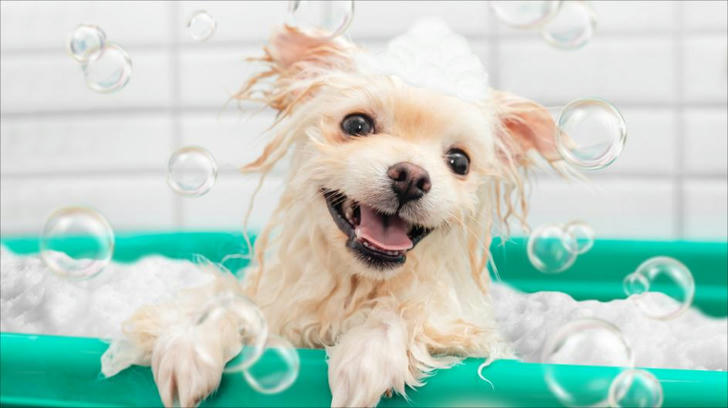
5. Tips for Handling Common Grooming Challenges
Managing Shedding
Dogs shed naturally, but you can reduce it by brushing them daily, especially during shedding seasons. Use an undercoat rake for double-coated breeds, like Huskies, to remove loose fur from the underlayer.
Preventing Matting in Long-Haired Breeds
For dogs with long hair, focus on daily brushing and detangling. Use a slicker brush to gently work through any knots before they become mats. Mats can be painful for dogs and may need to be cut out if left too long.
Making Grooming a Positive Experience
Reward your dog with treats and praise during grooming to create positive associations. Start slowly, especially if they’re not used to grooming, and gradually increase the time spent. This routine not only makes grooming easier but also builds trust.
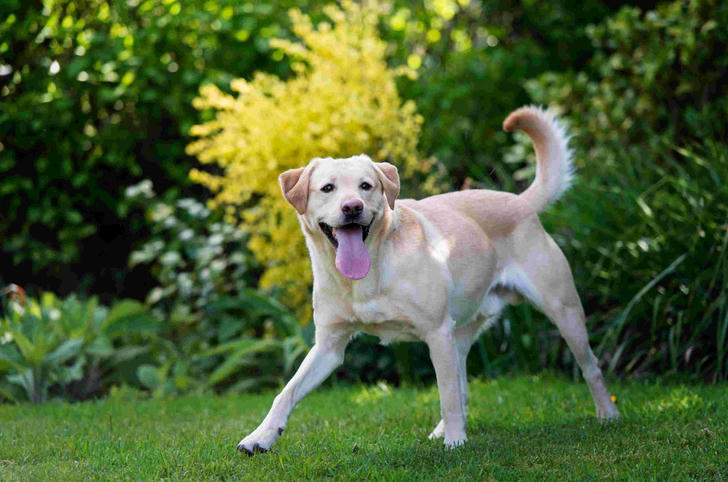
6. Creating a Sustainable Grooming Schedule
The goal of daily grooming is to create a habit that keeps your dog’s coat in top condition. A sample schedule might look like this:
Daily: Quick brushing, face cleaning, and check for parasites. Weekly: Thorough brushing, ear cleaning, and trimming around paws if necessary. Monthly: Full bath and nail trimming.
Example Schedule for a Poodle: Due to their curly coats, Poodles benefit from daily brushing and a full bath every 3–4 weeks.
Conclusion: Embrace the Routine
By following this daily grooming routine, you’ll keep your dog’s fur clean, tangle-free, and healthier overall. The steps outlined are straightforward, and with the right tools, daily grooming can become a bonding time that both you and your dog enjoy. Remember, consistency is key, and the effort you put into caring for your dog’s coat will make a noticeable difference in their health and happiness.
